“A Covenant Restored,” Tambuli, June 1991, 35
A Covenant Restored
Photographic Essay
A new permanent exhibit at the Museum of Church History and Art in Salt Lake City, Utah, tells the story of the conversion and commitment of the Latter-day Saints in the formative years of the Church.
The exhibit invites visitors to participate in the early Mormon experience, including the restoration of the gospel in New York; the gathering of the Saints in Ohio and Missouri and later in Illinois; the migration of the Saints to the Salt Lake Valley, Utah, by ship, covered wagon, and handcart; the building up of Zion in the American West; and the proclamation of the gospel to the world.
Some of those experiences are shared in this photographic essay of the exhibit that follows the pioneers across the ocean and across the Great Plains to their new home in the valley of the Great Salt Lake.
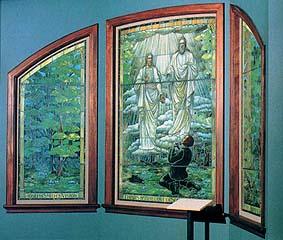
The First Vision is portrayed in this 1913 stained-glass window originally located in the Adams Ward chapel in Los Angeles, California. The 1820 appearance of God the Father and the Savior, in answer to young Joseph Smith’s prayer, was the beginning of the restoration of the gospel to the world.

An original window from the Kirtland (Ohio) Temple, which was completed in March 1836. To the right of the window in this display are an oil painting of Joseph Smith and the Church leaders in Nauvoo, Illinois; early church leader W. W. Phelps’s lap desk (on the chair); and a vest and pair of pants that belonged to Hyrum Smith, brother of the Prophet Joseph.
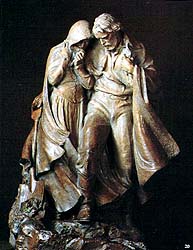
A bronze statue by Avard Fairbanks commemorates the deaths of hundreds of Saints during the first two years in the pioneer community of Winter Quarters.
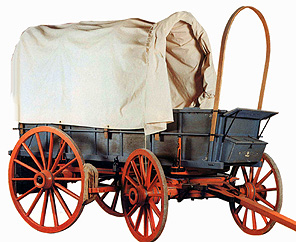
A replica of a typical covered wagon used by the Saints in making the great trek westward.
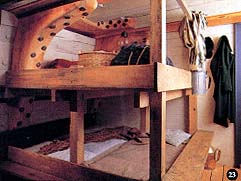
A special display in the museum exhibit depicts the sailing ships that carried thousands of emigrants across the Atlantic Ocean from Europe to their new homeland. This full-size replica of the passenger quarters was based on original construction plans of the Enoch Train, a ship that sailed from Liverpool, England, to Boston, Massachusetts. The voyage took two months.

Miniature scenes on board a model of the Enoch Train are patterned after actual events recorded in pioneer journals during an 1856 voyage when most of the passengers were from England. Others on board were from Scotland, Wales, Ireland, Denmark, and Switzerland.

Reproduced in 1:32 scale, the model of the Enoch Train took four years to make. It is complete even to such details as the sailors’ knots tied in the “ropes” to the sails.
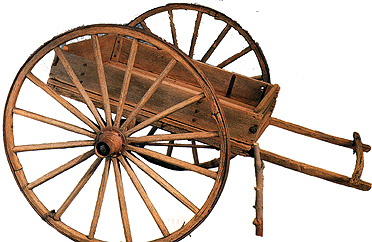
This handcart was pulled across the Great Plains in 1866 or 1867 by the William Stiff family of England. It is similar in type and style to those used ten years earlier by handcart companies promoted by the Church.

In 1866, pioneer photographer Charles Savage traveled from Salt Lake City to New York to purchase photographic equipment. On his return journey he joined the Thomas E. Ricks Emigration Company, made up of 251 British Saints traveling with forty-six wagons. His is a rare photographic record of an actual pioneer company.
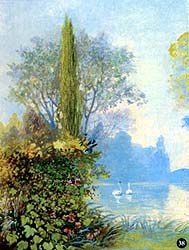
This oil sketch, attributed to Edwin Evans, was made about 1892. In the early 1890s, Evans was one of several “art missionaries” sent by the Church to study in Paris, France, in preparation for the task of painting the Salt Lake Temple murals depicting the creation of the earth, the Garden of Eden, and the world in which we live.
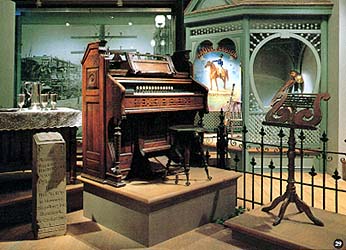
An organ originally used in the Manti (Utah) Temple is a reminder of the importance of music in Latter-day Saint worship.
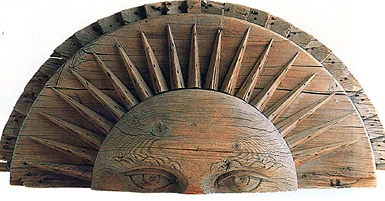
This wooden sunburst, once painted in brilliant colors, was carved in 1852 for the south gable of the old tabernacle that once stood on Temple Square, Salt Lake City. The sunburst symbolized the restoration of the gospel and the celestial glory of God.
Brigham Young’s compass.
C. C. A. Christensen’s painting of Winter Quarters, Nebraska, 1846–47; 3,500 Latter-day Saints built 700 log homes that provided shelter for thousands of pioneers traveling west between 1846 and 1862.
Photography by Craig Dimond